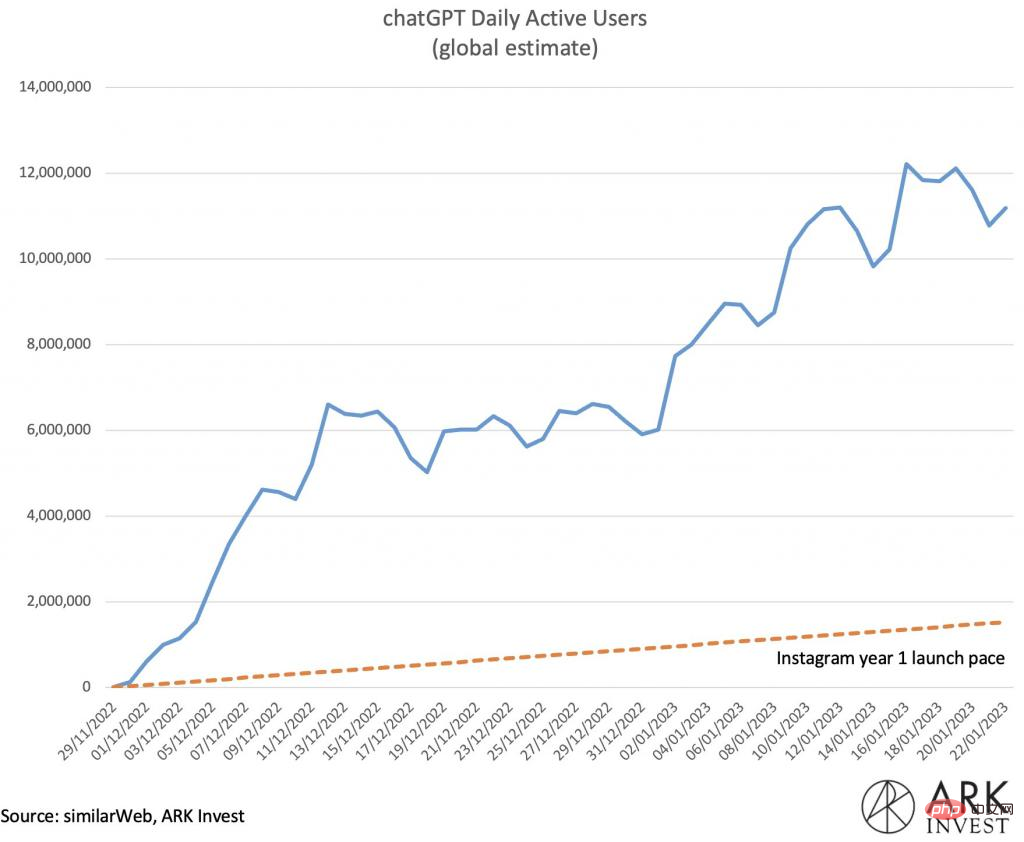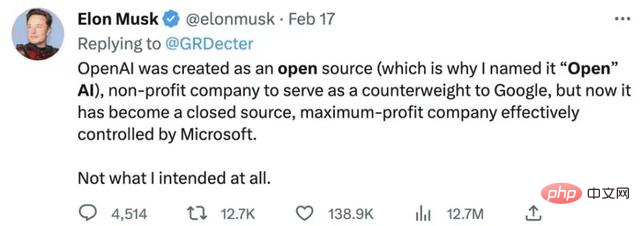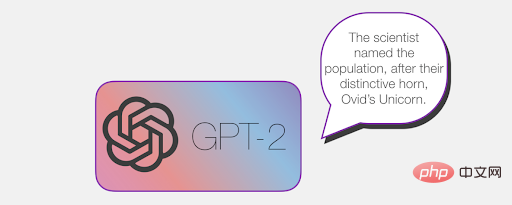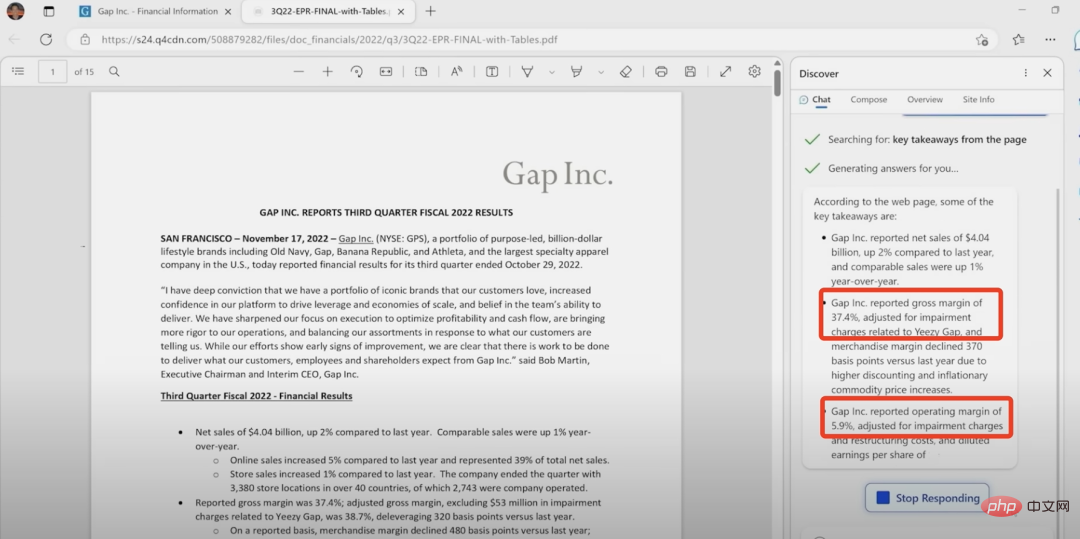 Technology peripherals
Technology peripherals
 AI
AI
 Why is ChatGPT popular, but OpenAI has not received widespread attention?
Why is ChatGPT popular, but OpenAI has not received widespread attention?
Why is ChatGPT popular, but OpenAI has not received widespread attention?
Big Data Digest Produced
Author: Caleb
I believe everyone has seen how popular ChatGPT is now.
According to statistics from Brett Winton, chief futurist of ARK Venture Capital, it took less than two months for ChatGPT’s daily activity to exceed 10 million. As a comparison, it took 355 days for the last phenomenal software, Instagram, to achieve this feat.

In mid-January, the New York Times reported that Antony Aumann, a philosophy professor at Northern Michigan University, was surprised to read an article that “the whole class read” while grading a course on world religions. Best Paper". Using concise paragraphs, well-placed examples, and rigorous arguments, students explore the moral implications of the burqa ban. However, under Aumann's questioning, the student admitted that the paper was written using ChatGPT.
There are many similar examples.
It is precisely with the explosion of ChatGPT on a global scale that OpenAI has been quickly pushed to the "cusp of the storm" of public opinion.
It can be said that OpenAI is currently leading the chatbot arms race. Taking ChatGPT as an example, the public release of the multi-billion-dollar cooperation with Microsoft not only stimulated Google and Amazon to urgently deploy artificial intelligence in their product lines, OpenAI also cooperated with Bain to introduce machine learning into Coca-Cola’s operations, and plans to expand to Other corporate partners.
There is no doubt that OpenAI’s artificial intelligence has become a big business, but in fact this is somewhat different from OpenAI’s original plan.
“The future of humanity should be determined by humans”
Last Friday, OpenAI CEO Sam Altman published a blog post titled “Planning for AGI and Beyond” and beyond).

https://www.php.cn/link/3187b1703c3b9b19bb63c027d8efc2f1
In the article , he claimed that OpenAI’s general artificial intelligence (AGI) is currently far from meeting the requirements. Many people doubt whether it can benefit all mankind and whether it “has the potential to bring incredible new abilities to everyone.” Altman used a broad, idealistic language to argue that the development of artificial intelligence should not stop. "The future of mankind should be determined by humans." This implicitly pointed to OpenAI. Almost during the period when ChatGPT became popular, this blog post and OpenAI’s recent actions constantly remind everyone how much OpenAI’s tone and mission have changed compared to when it was founded. In its early days, OpenAI was just a non-profit organization. Although the company has always been focused on AGI development, when it was founded, they promised not to pursue profits and share development code for free. Today, these promises are nowhere to be found. The driving force of OpenAI became speed and profitIn 2015, Altman, Musk, Peter Thiel, and Reid Hoffman announced the establishment of a non-profit research organization OpenAI. In its founding statement, OpenAI announced that its research is committed to "advancing artificial intelligence in ways most likely to benefit all of humanity, without being constrained by generating financial returns." The blog also states that "since our research has no financial obligation, it can better focus on positive human impacts" and encourages all researchers to share "papers, blog posts or code, our patents (if any) will be shared with the world”. Eight years later, we are faced with a company that is neither transparent nor driven by positive human impact. Instead, as many critics, including Musk, believe, OpenAI's motivation became speed and profit.
This also invisibly contributed to the company's change in direction in 2018. At that time, OpenAI sought some direction from capital resources, saying, "Our primary fiduciary responsibility is to humans. We anticipate that we will need to mobilize significant resources to complete our mission."
By March 2019, OpenAI had completely shed its non-profit title and established a “capped profit” unit. This allows OpenAI to begin accepting investments and will provide investors with profits capped at 100 times their investment.
This decision was seen as a competition with big technology companies such as Google, and soon the company also received a US$1 billion investment from Microsoft as it wished. In a blog post announcing the for-profit company, OpenAI continued to use the same rhetoric, declaring that its mission is to "ensure that general artificial intelligence benefits all humanity."
But as Motherboard writes, it’s hard to believe that venture capitalists can save humanity when their main goal is profit.
Is OpenAI still worthy of the public’s trust?
In 2019, OpenAI faced public backlash when it announced and released the GPT-2 language model.
Initially, the company said it would not release the source code for the trained model due to "concerns about malicious applications of the technology." While this partly reflects its commitment to developing beneficial artificial intelligence, it's also not very "open."
Critics wondered why OpenAI would announce a tool but not release it, and many thought it was just a publicity stunt. It wasn't until three months later that OpenAI released the model on GitHub, saying the move was "an important foundation for the responsible release of artificial intelligence, especially when it comes to powerful generative models."

According to investigative reporter Karen Hao, who spent several days inside the company during 2020, OpenAI’s internal culture began to no longer reflect a cautious, research-driven approach. The AI development process is instead more focused on getting ahead, which has also led to accusations that it contributes to the “AI hype cycle.” Employees are also now required to remain silent about the work at hand to comply with the company's new bylaws.
"There is a misalignment between what the company publicly espouses and how it operates behind closed doors. Over time, it has allowed fierce competition and increasing financial pressures to erode its founding ideals of transparency, openness and collaboration ." Hao wrote.
But overall, the launch of GPT-2 is undoubtedly an event worth celebrating for OpenAI, and it is also an important cornerstone of the company's development to this day. “It’s definitely part of the success story framework,” Miles Brundage, now director of policy research, said at a conference. “That part of the story goes something like this: We did something ambitious, and now some people are replicating it. There should also be some explanation of the benefits of this innovation”.
Since then, OpenAI has retained the hype part of the GPT-2 release formula, but eliminated the openness. In 2020, GPT-3 was officially launched and quickly “exclusively” licensed to Microsoft. The source code of GPT-3 has not yet been released, although OpenAI is currently intensively preparing for GPT-4; the model is only open to the public through ChatGPT’s API, and OpenAI has also launched a paid layer to guarantee access to the model.
Of course there are some considerations for doing this. The first is money. "Commercializing the technology helps pay for our ongoing AI research, safety and policy work," OpenAI said in an API announcement blog. The second reason is the bias towards helping large companies. “It’s difficult for anyone but big companies to benefit from the underlying technology.” Finally, the company also says that releasing via an API rather than open source is safer because the company can deal with abuse.
“You guys keep telling us AGI is fast, but there’s not even a consistent definition on your website,” computer scientist Timnit Gebru said on Twitter.
Emily M. Bender, a professor of linguistics at the University of Washington, said on Twitter, “They don’t want to solve real problems in the real world (which would require ceding power). They want to believe they are gods who can not only create A 'superintelligence' that has the grace to do so in a way that is 'consistent' with humans."
Will this artificial intelligence be shared responsibly, developed openly, and with no profit motive, as the company originally envisioned? Or will it be rushed out, with a lot of troubling flaws, but mostly to generate revenue for OpenAI? Will OpenAI keep its sci-fi future closed-source?
After being combined with ChatGPT, Microsoft’s Bing chatbot is in a state of “obsession”, constantly deceiving and scolding users, and spreading misinformation. OpenAI cannot reliably detect text generated by its own chatbot, even as educators are increasingly concerned about students using the app to cheat.

People have also easily jailbroken language models, ignoring the guardrails OpenAI has put around them, with the bot crashing when fed random words and phrases. No one can say clearly why, because OpenAI does not share the code of the underlying model, and perhaps to some extent, OpenAI itself is unlikely to fully understand how it works.
With all of this in mind, we should all carefully consider whether OpenAI is worthy of the trust it is asking the public to give, to which it has not responded in any substantive way.
Related reports:https://www.php.cn/link/b4189d9de0fb2b9cce090bd1a15e3420
The above is the detailed content of Why is ChatGPT popular, but OpenAI has not received widespread attention?. For more information, please follow other related articles on the PHP Chinese website!

Hot AI Tools

Undresser.AI Undress
AI-powered app for creating realistic nude photos

AI Clothes Remover
Online AI tool for removing clothes from photos.

Undress AI Tool
Undress images for free

Clothoff.io
AI clothes remover

AI Hentai Generator
Generate AI Hentai for free.

Hot Article

Hot Tools

Notepad++7.3.1
Easy-to-use and free code editor

SublimeText3 Chinese version
Chinese version, very easy to use

Zend Studio 13.0.1
Powerful PHP integrated development environment

Dreamweaver CS6
Visual web development tools

SublimeText3 Mac version
God-level code editing software (SublimeText3)

Hot Topics
 ChatGPT now allows free users to generate images by using DALL-E 3 with a daily limit
Aug 09, 2024 pm 09:37 PM
ChatGPT now allows free users to generate images by using DALL-E 3 with a daily limit
Aug 09, 2024 pm 09:37 PM
DALL-E 3 was officially introduced in September of 2023 as a vastly improved model than its predecessor. It is considered one of the best AI image generators to date, capable of creating images with intricate detail. However, at launch, it was exclus
 Choosing the embedding model that best fits your data: A comparison test of OpenAI and open source multi-language embeddings
Feb 26, 2024 pm 06:10 PM
Choosing the embedding model that best fits your data: A comparison test of OpenAI and open source multi-language embeddings
Feb 26, 2024 pm 06:10 PM
OpenAI recently announced the launch of their latest generation embedding model embeddingv3, which they claim is the most performant embedding model with higher multi-language performance. This batch of models is divided into two types: the smaller text-embeddings-3-small and the more powerful and larger text-embeddings-3-large. Little information is disclosed about how these models are designed and trained, and the models are only accessible through paid APIs. So there have been many open source embedding models. But how do these open source models compare with the OpenAI closed source model? This article will empirically compare the performance of these new models with open source models. We plan to create a data
 A new programming paradigm, when Spring Boot meets OpenAI
Feb 01, 2024 pm 09:18 PM
A new programming paradigm, when Spring Boot meets OpenAI
Feb 01, 2024 pm 09:18 PM
In 2023, AI technology has become a hot topic and has a huge impact on various industries, especially in the programming field. People are increasingly aware of the importance of AI technology, and the Spring community is no exception. With the continuous advancement of GenAI (General Artificial Intelligence) technology, it has become crucial and urgent to simplify the creation of applications with AI functions. Against this background, "SpringAI" emerged, aiming to simplify the process of developing AI functional applications, making it simple and intuitive and avoiding unnecessary complexity. Through "SpringAI", developers can more easily build applications with AI functions, making them easier to use and operate.
 Rust-based Zed editor has been open sourced, with built-in support for OpenAI and GitHub Copilot
Feb 01, 2024 pm 02:51 PM
Rust-based Zed editor has been open sourced, with built-in support for OpenAI and GitHub Copilot
Feb 01, 2024 pm 02:51 PM
Author丨Compiled by TimAnderson丨Produced by Noah|51CTO Technology Stack (WeChat ID: blog51cto) The Zed editor project is still in the pre-release stage and has been open sourced under AGPL, GPL and Apache licenses. The editor features high performance and multiple AI-assisted options, but is currently only available on the Mac platform. Nathan Sobo explained in a post that in the Zed project's code base on GitHub, the editor part is licensed under the GPL, the server-side components are licensed under the AGPL, and the GPUI (GPU Accelerated User) The interface) part adopts the Apache2.0 license. GPUI is a product developed by the Zed team
 Posthumous work of the OpenAI Super Alignment Team: Two large models play a game, and the output becomes more understandable
Jul 19, 2024 am 01:29 AM
Posthumous work of the OpenAI Super Alignment Team: Two large models play a game, and the output becomes more understandable
Jul 19, 2024 am 01:29 AM
If the answer given by the AI model is incomprehensible at all, would you dare to use it? As machine learning systems are used in more important areas, it becomes increasingly important to demonstrate why we can trust their output, and when not to trust them. One possible way to gain trust in the output of a complex system is to require the system to produce an interpretation of its output that is readable to a human or another trusted system, that is, fully understandable to the point that any possible errors can be found. For example, to build trust in the judicial system, we require courts to provide clear and readable written opinions that explain and support their decisions. For large language models, we can also adopt a similar approach. However, when taking this approach, ensure that the language model generates
 How to install chatgpt on mobile phone
Mar 05, 2024 pm 02:31 PM
How to install chatgpt on mobile phone
Mar 05, 2024 pm 02:31 PM
Installation steps: 1. Download the ChatGTP software from the ChatGTP official website or mobile store; 2. After opening it, in the settings interface, select the language as Chinese; 3. In the game interface, select human-machine game and set the Chinese spectrum; 4 . After starting, enter commands in the chat window to interact with the software.
 Can chatgpt be used in China?
Mar 05, 2024 pm 03:05 PM
Can chatgpt be used in China?
Mar 05, 2024 pm 03:05 PM
chatgpt can be used in China, but cannot be registered, nor in Hong Kong and Macao. If users want to register, they can use a foreign mobile phone number to register. Note that during the registration process, the network environment must be switched to a foreign IP.
 Don't wait for OpenAI, wait for Open-Sora to be fully open source
Mar 18, 2024 pm 08:40 PM
Don't wait for OpenAI, wait for Open-Sora to be fully open source
Mar 18, 2024 pm 08:40 PM
Not long ago, OpenAISora quickly became popular with its amazing video generation effects. It stood out among the crowd of literary video models and became the focus of global attention. Following the launch of the Sora training inference reproduction process with a 46% cost reduction 2 weeks ago, the Colossal-AI team has fully open sourced the world's first Sora-like architecture video generation model "Open-Sora1.0", covering the entire training process, including data processing, all training details and model weights, and join hands with global AI enthusiasts to promote a new era of video creation. For a sneak peek, let’s take a look at a video of a bustling city generated by the “Open-Sora1.0” model released by the Colossal-AI team. Open-Sora1.0





